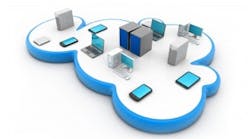Jim Montague is the executive editor for Control. Email him at [email protected].
As long as the intelligent and useful decisions get made, it doesn't matter over what physical or intangible avenue their supporting data travels, but they still need some kind of pathway. Fortunately, Rockwell Automation has long cultivated open networking, so it can now offer all the wired and wireless hooks —across in-plant networks and over the cloud — its customers need to realize the Connected Enterprise.
"To us, big data means all the information running on plant floors, so our mission is to help our customers find the best ways to make sense of it all," says Keith McPherson, market development director, Rockwell Software. "So we help users connect to their information, organize it, put it into the right context, set up dashboards and distribute it to the right individuals who can make better and more profitable decisions."
SEE ALSO: More on Cloud Computing: What Does It Really Do?
McPherson and John Lohmann, market development director for services and solutions at Rockwell Software, conducted the "Cloud, Virtualization and Other Enabling Technologies" tour at the Information Software exhibit this week at the Automation Fair event in Houston presented by Rockwell Automation. The booth demonstrates how Rockwell Automation's Connected Enterprise initiative enables collaboration across all levels of its customers' organizations by connecting manufacturers with their supply chains and giving better insight into their needs. However, it also shows how employees can connect to each another for easy collaboration and problem solving, and how they can tie their businesses together from the plant floor to the IT and enterprise levels. It's these higher levels of collaboration that can help drive productivity improvements, innovation and ultimately optimize business processes.
"We bet the farm a long time ago on our Integrated Architecture, which is based on open, standard Ethernet, web and mobile connectivity," explained McPherson. "That's what's making it easier for us to implement the virtual computing and cloud-based services so many users are asking for now."
"We bet the farm a long time ago on our Integrated Architecture, which is based on open, standard Ethernet, web and mobile connectivity." Rockwell Automation's Keith McPherson on why the company is well prepared to help its customers benefit from public and private cloud technology.
Lohmann added that, "Besides dealing with the strain of aging workforces, many users are still working with assets that must perform in harsh and difficult environments, so our ability to leverage open networks and the cloud can help users with all their logistics issues and people challenges."
For instance, McPherson reported that M.G. Bryan Equipment Co. in Grand Prairie, Texas, is implementing Rockwell Automation's cloud-based solutions and Microsoft's Azure platform on its fracking trucks. The platform provides generic Internet connections for tablet PCs and smart phones, so Bryan's users can secure production data from the trucks and their drill sites. For example, this enables the trucks to alert operators when their air filters need to be changed, which can be as often as every eight hours.
"Basically, sensors and other field-based devices provide data via real-time production models to our FactoryTalk VantagePoint software, which builds reports and displays," said McPherson. "But now, M.G. Bryan's users can use iPads and Gmail to log in to their trucks, check actual data dashboards with real-time parameters and even initiate immediate orders for service or supplies."
In fact, Rockwell Software just announced this week its FactoryTalk VantagePoint Mobile App, which is based on FactoryTalk VantagePoint's enterprise manufacturing intelligence (EMI) software, Version 5.0. Featuring Windows 8-style on-screen tiles, this new app can provide any KPIs that users need right at their fingertips, McPherson said. The app will be released this December, while versions for Apple's iOS and Google's Android operating systems are scheduled to ship in early 2014.
"Users can set any alerts or notifications they want, and then the software will display high-level gauges; allow users to immediately drill down into more detailed VantagePoint reports; and allow them to distribute specific information to colleagues via email, Facebook, Twitter and Microsoft OneNote," added McPherson.
To help support all these apps, big data and cloud-based projects with some heavy-duty virtualization hardware, Rockwell Automation also released this week its new Industrial Data Center, which is a pre-engineered, scalable infrastructure that lets users run multiple operating systems and applications on virtualized servers. Available for lease or sale, this center's main components include rack-mounted blade servers from VMWare, networking from Cisco, an enclosure and temperature controls by Panduit, and the ability to run a variety of FactoryTalk, PlantPAx and other software packages on a user's private cloud.
"Industrial Data Center moves having your own cloud from a capital expense to an operating expense, which can make it a lot more approachable for many users," says McPherson. "It also follows the basic Microsoft model, so users can have one, four or 16 cores, which makes it easy to scale up as needed. The cloud has two main value propositions: improving asset performance management and enabling remote monitoring to virtually support engineering functions."
For example, Lohmann reported that Hilcorp's submersible, medium-voltage pumps had only been running for a short time on a user's oil platform in Alaska earlier this summer, when they started generating alerts that were uploaded via Rockwell Automation's cloud-based service to Hilcorp's office in Cleveland. "The customer reported that these alerts from the cloud enabled their operators and saved about six hours of unplanned downtime," added Lohmann. "The advantages of cloud and virtual computing will continue to converge in the future. We're already using them and their flexibility to learn and work closer with customers, so we can better tailor these tools to meet the individual needs of their applications."








